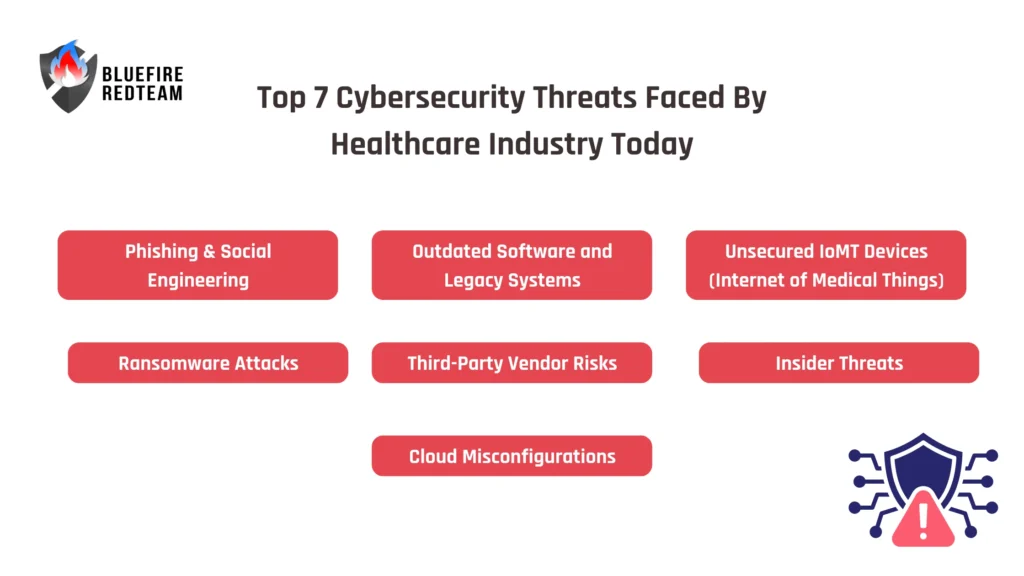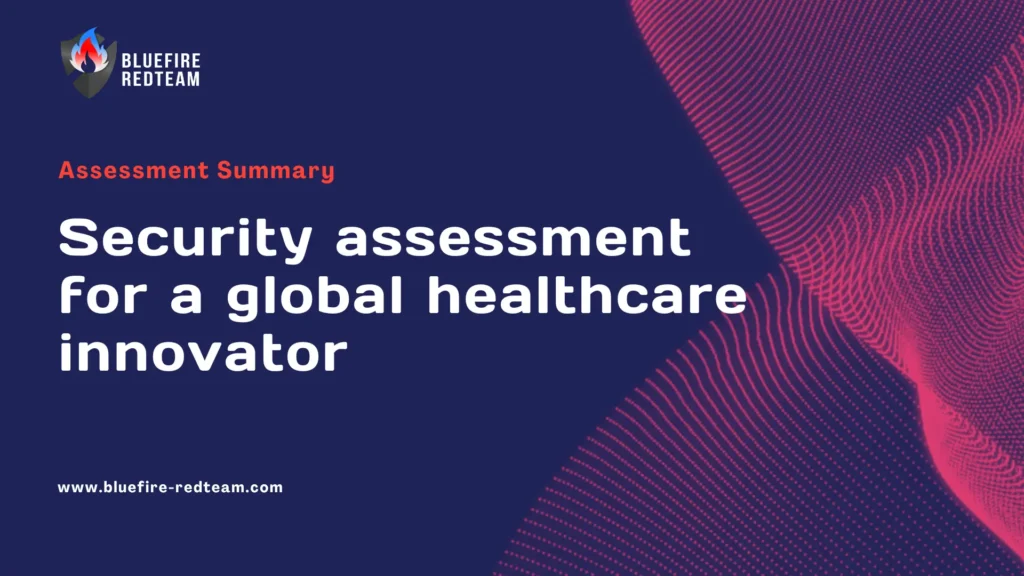An unparalleled digital revolution is taking place in the healthcare industry. Technology is enhancing patient care through connected IoMT devices, telemedicine, and electronic health records (EHRs), but it is also making sophisticated cyberthreats more accessible. The CyberPeace Foundation reported in 2024 that one of the sectors most frequently targeted by cybercriminals worldwide was healthcare.
The importance of protecting patient data is increasing along with its value. This article examines the top seven cybersecurity risks facing the healthcare sector and how businesses can protect themselves.

1. Ransomware Attacks
The biggest threat to clinics and hospitals is still ransomware. Critical medical data is encrypted by cybercriminals, who then demand ransom payments to restore access.
Impact:
- Disrupted patient care
- Financial losses
- Data leakage
Solution:
- Regular backups
- VAPT testing to identify exploitable vulnerabilities
- Network segmentation and incident response planning
2. Phishing & Social Engineering
Phishing emails that pose as internal staff or reliable vendors frequently target healthcare workers.
Impact:
- Compromised credentials
- Unauthorised access to EHR systems
- Malware infections
Solution:
- Security awareness training
- Multi-factor authentication (MFA)
- Email filtering solutions
3. Outdated Software and Legacy Systems
Because so many healthcare facilities continue to use unsupported operating systems and apps, they are prime targets for hackers.
Impact:
- High exploitability
- Vulnerability to zero-day attacks
Solution:
- Regular patch management
- Asset inventory
- Penetration testing to detect exploitable weaknesses
4. Unsecured IoMT Devices (Internet of Medical Things)
Insulin pumps, imaging equipment, and monitors are examples of connected devices that frequently lack the necessary encryption and security measures.
Impact:
- Remote hijacking of devices
- Patient safety risk
Solution:
- Secure device onboarding
- Network segmentation
- Continuous monitoring of connected devices
5. Third-Party Vendor Risks
Data sharing between healthcare organisations and outside labs, billing services, and SaaS providers is common.
Impact:
- Data breaches from insecure partners
- HIPAA violations
Solution:
- Conduct third-party risk assessments
- Enforce SLAs with cybersecurity clauses
- Regular VAPT of vendor-facing APIs
6. Insider Threats
Insiders have the potential to reveal private patient information, whether on purpose or accidentally.
Impact:
- Compliance violations
- Loss of patient trust
Solution:
- Role-based access controls (RBAC)
- Activity monitoring and alerting
- Employee exit protocols
7. Cloud Misconfigurations
As more patient records are stored in the cloud, improper setups may make private information publicly available.
Impact:
- Public data leaks
- Regulatory penalties
Solution:
- Cloud security posture management (CSPM)
- Penetration testing of cloud assets
- Zero-trust architecture
Case Study: Security Assessment For A Global Healthcare Innovator

Client: A leading healthcare innovator in the UK.
Challenge:
They encountered serious cybersecurity issues with both their mobile and web apps. These flaws presented compliance issues in addition to endangering user data. The client needed to strengthen their defences in order to preserve credibility and trust as regulatory scrutiny increased.
Bluefire Redteam’s Solution:
Our team carefully examined the client’s digital assets in order to address their security concerns. We identified vulnerabilities and created a defence roadmap by combining our manual expertise with cutting-edge tools. Our investigation revealed a number of vulnerabilities, all of which need to be fixed right away.
Findings
Equipped with our discoveries, the customer fortified their online defences. Through proactive steps and remediation efforts, they reduced risks and protected user data.
Read their verified review here.
Why Choose Bluefire Redteam for Healthcare Cybersecurity?
Protecting healthcare companies of all sizes is our area of expertise at Bluefire Redteam. Among our cybersecurity offerings are:
- HIPAA-compliant VAPT Assessments
- Healthcare-focused Red Teaming
- Cloud and IoMT Security
- 24/7 Threat Monitoring & Incident Response
We don’t just test—we help you remediate, comply, and build cyber resilience.
Time and again, we are recognized as one of the Top Award-Winning VAPT Providers
Let’s protect what matters most—your sensitive data.
📩 Book a free consultation with our healthcare cybersecurity experts today.
FAQs: Cybersecurity in Healthcare
- What makes healthcare such a prime target for cyber attacks?On the dark web, medical data is much more valuable than financial data. Modern cybersecurity defences are also lacking in many institutions.
- Is VAPT mandatory in the healthcare sector?VAPT is essential for HIPAA and GDPR compliance, even though it isn't always required by law.
- How often should a hospital perform a VAPT assessment?
Ideally once every 6-12 months, or after any major system change or cyber incident.
- Can small healhcare companies also be targeted by cybercriminals?
Absolutely. Small healthcare companies are often more vulnerable due to weaker security controls.


